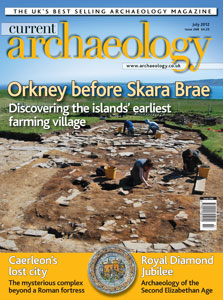Orkney has been called the Egypt of the north. Studded with spectacular prehistoric monuments, the ancient landscape remains a powerful presence. Yet excavations continue to surprise. The island of Wyre was thought to be devoid of prehistoric activity until recent fieldwalking harvested a wealth of Neolithic finds. Wondering if this could be another Skara Brae, the team had instead discovered the earliest farming village ever found on the islands.
Caerleon is another of Britain’s outstanding sites. Home to the Second Augustan legion for over 200 years, over a century of research has been devoted to establishing its layout. Now 24 days of geophysics has filled in much of the remainder, while further survey detected a completely unexpected monumental complex beyond the fortress walls. Flush with courtyards and what appear to be bath-houses and basilicas, excavation has revealed stunning preservation. But what was the complex for?
Anglo-Saxon art has long brought a touch of glitter to the so-called Dark Ages, but what do the messages conveyed by such complex and subtle decorations mean? Rather than a stark rejection of preceding Roman styles, we see how a fusion of Roman, Germanic and Biblical influences allowed their creators to stake a claim to being the heirs of empire.
Finally, as the country celebrates the Diamond Jubilee of Queen Elizabeth II, we investigate the archaeological legacies of her reign, and of royal jubilees themselves. Archaeology has come a long way over the last 60 years. It is astonishing to think that 45 of them could be followed as they happened in the pages of Current Archaeology.
FEATURES/n
ORKNEY’S FIRST FARMERS/n
Early Neolithic settlement on Wyre
What can a recently-discovered site on one of Scotland’s smallest islands tell us about life in Orkney before Skara Brae?
LOST CITY OF THE LEGION?/n
Excavating Caerleon
Investigations at a Roman fort in Wales have uncovered a monumental building complex bigger than Fishbourne Palace.
FINDING MEANING IN ANGLO-SAXON ART/n
Fusing the Roman, the Germanic and the Biblical
What can Saxon symbolism tell us about cultural influences and politics of the time?
JOHNNY AND THE PRINCE/n
Archaeological legacies of the Queen’s Diamond Jubilee
How has Elizabeth II’s reign affected heritage, and what can archaeology tell us about past jubilees?
NEWS/n
Furness’ mystery Cistercian; Scanning Skomer; Cease and de-cist; Glastonbury glassworks; ‘Gateway toLondon’ re-opens; Lost landscapes; Cutty Sark relaunched; Getting ahead.
REGULARS/n
Context
Introducing Henry Stuart, England’s ‘lost prince’.
Reviews
The Western Brecon Beacons; Cairns, fields, and cultivation; Medieval rural settlement; Roman camps in Britain
Sherds
Chris Catling’s irreverent take on heritage issues.
Opinion
Mark Horton looks to the future of how we study the past
Odd Socs
Dating Old Welsh Houses Group

